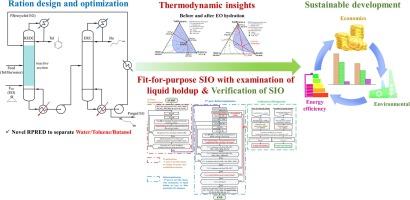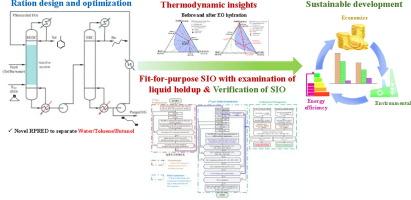改进的顺序迭代优化方法探讨反应萃取精馏分离水/甲苯/正丁醇的合理设计
IF 9
1区 工程技术
Q1 ENGINEERING, CHEMICAL
引用次数: 0
摘要
从工业废水中高效回收正丁醇(Bu)和甲苯(Tol)在实现可持续化学工业实践中发挥着重要作用。在这项工作中,我们报告了一种减压反应萃取精馏和溶剂回收塔(RPRED),通过热力学分析分离了水/Tol/Bu的三元共沸混合物,这比传统的变压蒸馏配置具有更好的技术经济和环境性能。首先,通过三元相图分析了EO水化前后两种共沸体系的热力学方面、工艺可行性以及RPRED工艺的概念设计。工作的第二部分侧重于顺序迭代优化(SIO)方法,通过验证迭代循环中托盘上的液含率来执行合理优化,该方法考虑了确定压力边界、回流比、以及基于Tol/Bu/乙二醇(EG)现有蒸馏边界的馏出率,以及随后的年总成本最小化,以在精细化优化回路上获得可行的解决方案。第三部分将SIO结果与两种基于遗传算法的优化方案进行了比较,包括SIO方法的收敛液含率和变化液含率,这验证了我们提出的SIO程序的可靠性。工作的第四部分使用传统的SIO优化配置,包括滗析和变压蒸馏(DPSD)方案,这是在我们之前的工作中开发的,作为与RPRED比较的基线。总的来说,相对于DPSD配置,RPRED配置具有更好的经济、环境和热力学效率。本文章由计算机程序翻译,如有差异,请以英文原文为准。


Insight into the rational design of reactive-extractive distillation for separating water/toluene/n-butanol via an improved sequential iterative optimisation
High-efficiency recovery of n-butanol (Bu) and toluene (Tol) from industrial wastewater plays a significant role in enabling sustainable chemical industry practices. In this work, we report a reactive-extractive distillation at reduced pressure and a solvent recovery column (RPRED) for separating a ternary azeotropic mixture of water/Tol/Bu via thermodynamic insights, which resulted in better technoeconomic and environmental performance than the conventional pressure swing distillation configuration. The work began by analysing the thermodynamic aspects of two azeotropic systems before and after EO hydration, the process feasibility, and the conceptual design of the RPRED process via ternary phase diagrams. The second part of the work focuses on a sequential iterative optimisation (SIO) approach with the verification of liquid holdup on trays in the iteration loop to perform rational optimisation, which considers the preoptimisation loop of determining the pressure boundary, the reflux ratio, and the distillate rate on the basis of the existing distillation boundary of Tol/Bu/ethylene glycol (EG) and the subsequent minimization of total annual cost to achieve a feasible solution at the refined optimisation loop. The third part of the work compares the SIO results with those of two genetic algorithm-based optimisation schemes, including the converged liquid holdup of the SIO approach and varying liquid holdup, which validates the reliability of our proposed SIO procedure. The fourth part of the work uses a conventional SIO optimised configuration consisting of the decantation and pressure swing distillation (DPSD) scheme, which was developed in our previous work, as a baseline of comparison against RPRED. Overall, the RPRED configuration resulted in superior economic, environmental, and thermodynamic efficiency performance relative to the DPSD configuration.
求助全文
通过发布文献求助,成功后即可免费获取论文全文。
去求助
来源期刊

Separation and Purification Technology
工程技术-工程:化工
CiteScore
14.00
自引率
12.80%
发文量
2347
审稿时长
43 days
期刊介绍:
Separation and Purification Technology is a premier journal committed to sharing innovative methods for separation and purification in chemical and environmental engineering, encompassing both homogeneous solutions and heterogeneous mixtures. Our scope includes the separation and/or purification of liquids, vapors, and gases, as well as carbon capture and separation techniques. However, it's important to note that methods solely intended for analytical purposes are not within the scope of the journal. Additionally, disciplines such as soil science, polymer science, and metallurgy fall outside the purview of Separation and Purification Technology. Join us in advancing the field of separation and purification methods for sustainable solutions in chemical and environmental engineering.
 求助内容:
求助内容: 应助结果提醒方式:
应助结果提醒方式:


